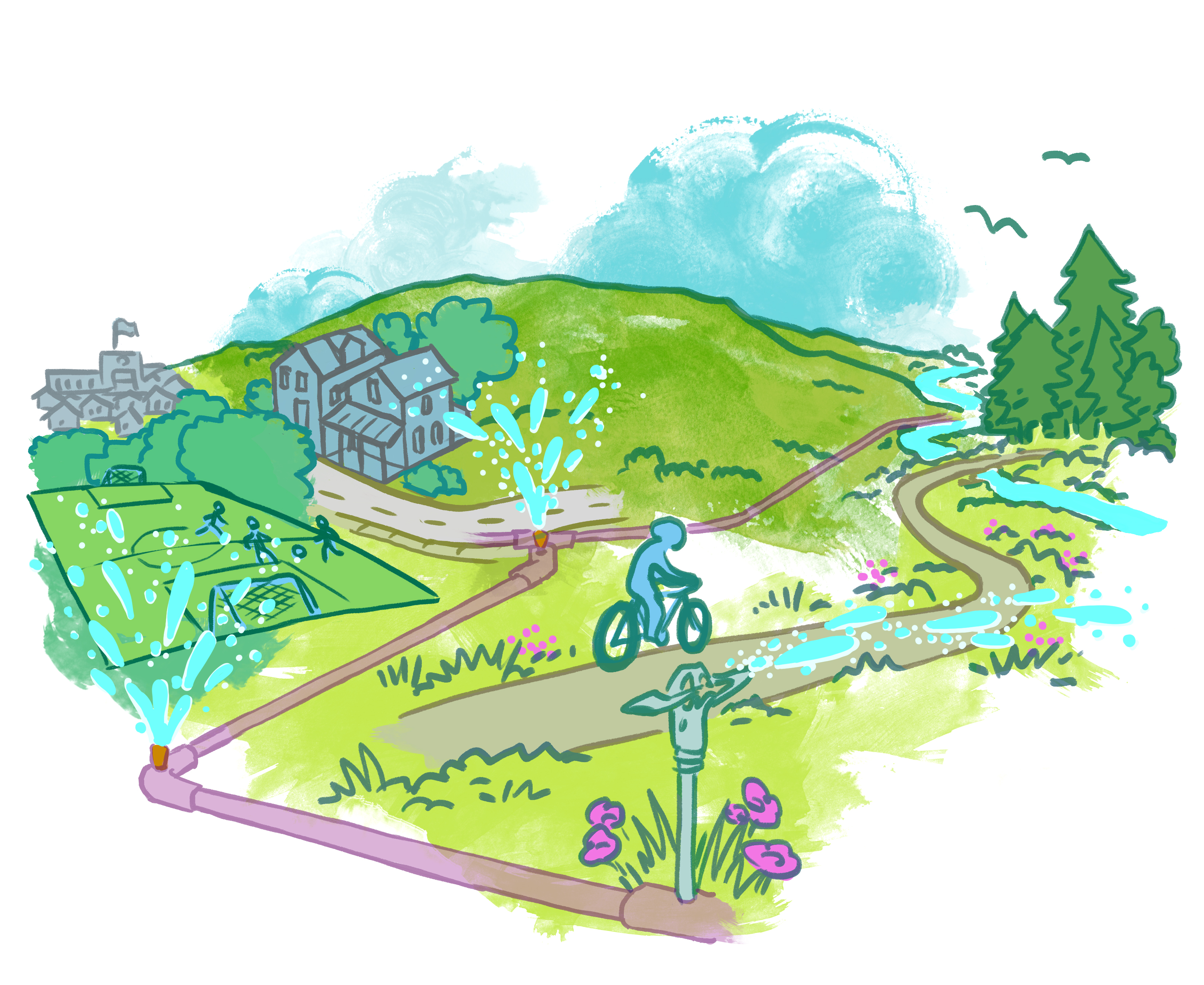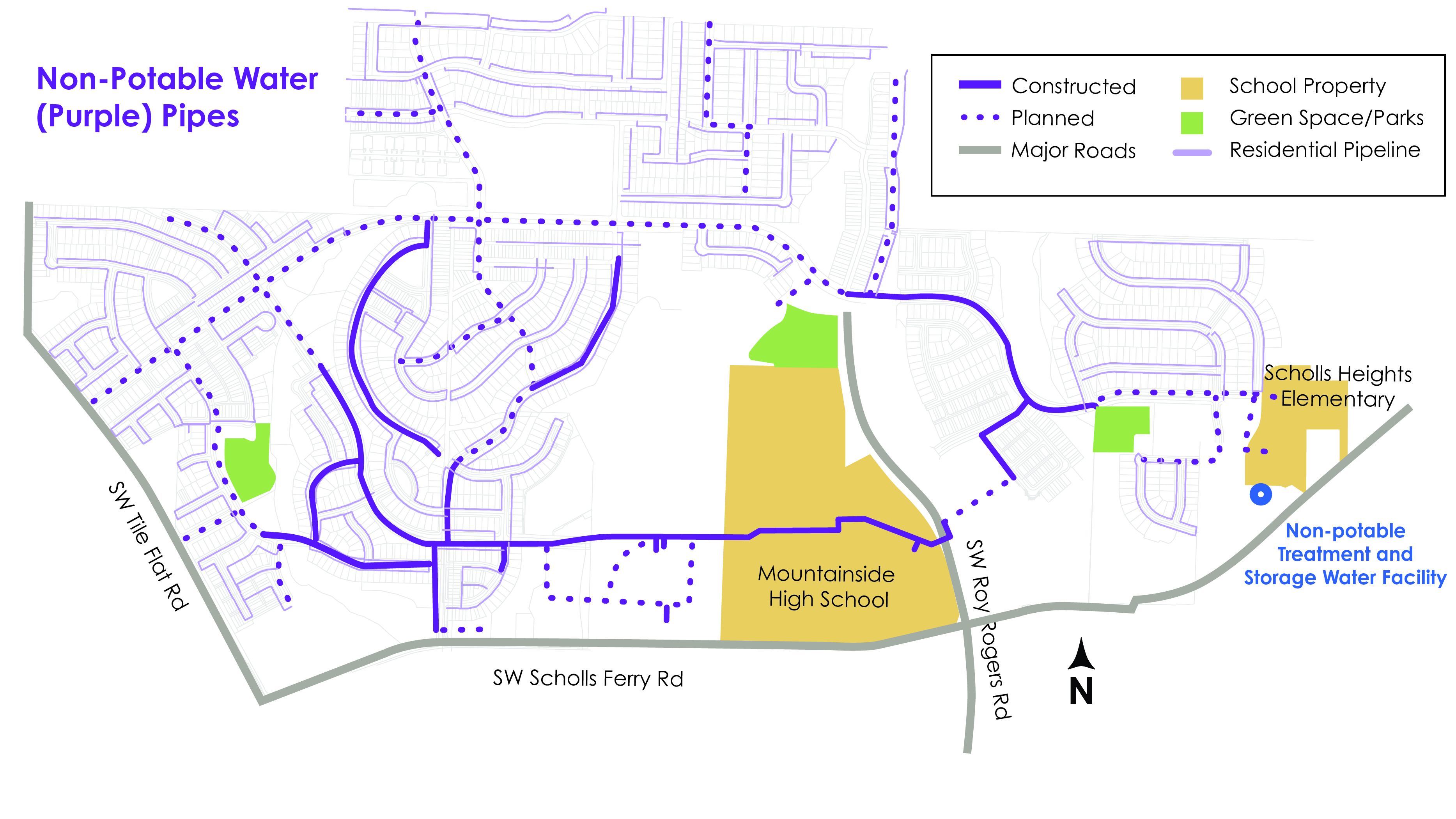Beaverton Purple Pipe
Connecting the right water with the right uses.
What is the Purple Pipe program?
The Beaverton Purple Pipe program waters our green spaces and conserves our most precious natural resource: clean water.
Beaverton’s drinking water is a precious and limited resource. Treatment and testing make it safe and healthy for us to drink, but our parks and yards do not need such high-quality water. Using drinking water for irrigation is currently the only available option because our city only has one set of water pipes.
The Beaverton Purple Pipe program is a new water system that routes cleaned stormwater to irrigate green spaces like parks, school grounds and yards and for stream recharge.
The Beaverton Purple Pipe program is:
Environmentally responsible
The program puts water to use that could not otherwise be used, meaning we’ll take less water from the Tualatin River. Also, more than half the stormwater treated by the system will go into local streams to increase summer flows.
Fiscally sound
Providing chlorinated, fluoridated drinking water is expensive, and such high-quality water is not needed for irrigation purposes. As our city’s water needs grow, matching the right water with the right uses will help keep costs down.
Forward looking
This program is about Beaverton working towards the future we want to see—in which water resources are thoughtfully conserved, the impact of urban development on natural environments is lessened, and our municipal water system supports this vision.
Visit the things to know page to learn more!
Project News
Construction Update: Construction of the Purple Pipe continues. Approximately 9,500 Linear Feet has now been installed in the Scholls Valley Heights and Scholls Heights area.
January 2022: Land use approval for the project site (Jan. 27, 2022)
December 2021: City of Beaverton proposes Aquifer Storage and Recovery (ASR) 3 Facility Purple Pipe project
May 2021: Council approval of treated stormwater as source for the Purple Pipe system.

Did you know...
Only about 1% of drinking water in the U.S is used for drinking? Other uses often do not need such high quality water.
Things to know about the Beaverton Purple Pipe program:
- This is a visionary project for Oregon. While similar approaches have been used for years in places such as the southwestern U.S., this will be the first of its kind in our region.
- The program is designed to provide mutual benefit to community members, developers and water suppliers. It’s an investment that’s intended to pay back for decades to come.
- The water is safe. Stormwater will be collected and treated before storage in the aquifer alongside naturally occurring groundwater. The quality of the water can be compared to the quality of water in local streams.
Now is the time
Our community is growing and so are our water needs. The Purple Pipe program works toward the community’s long-term goals of creating a reliable and sustainable water supply. Current growth provides the opportunity to build the Purple Pipe system as areas develop. This minimizes the impacts of adding water pipelines to established neighborhoods. We believe everyone in Beaverton will benefit from the environmental benefits of the new system. Approximately 2.5 miles of pipe have already been installed in the South Cooper Mountain neighborhood. The system will be expanded in the future, coordinated with development planning processes.
Map of the current and proposed Beaverton Purple Pipe network

Project news
Check back regularly for updated information.
-
Construction Update: Construction of the Purple Pipe continues. Approximately 9,500 Linear Feet has now been installed in the Scholls Valley Heights and Scholls Heights area.
-
January 2022: Land use approval for the project site (Jan. 27, 2022)
-
December 2021: City of Beaverton proposes Aquifer Storage and Recovery (ASR) 3 Facility Purple Pipe project. Check out the Tualatin Riverkeepers public comment here.
-
May 2021: Council approval of treated stormwater as source for the Purple Pipe system. For more information, check out the Agenda Bill.
-
September 2020: Adoption of South Cooper Mountain Ordinance
Library
- Beaverton Purple Pipe Factsheet, Spring 2022
- Backflow Prevention Factsheet - Spring 2022
- Homeowners guide coming soon!
Visit our frequently asked questions page to learn more about Purple Pipes
Frequently Asked Questions
1. What is the Beaverton Purple Pipe program?
2. What does “connecting the right water with the right uses” mean?
3. Why is the City installing the Beaverton Purple Pipe system?
5. What kind of water will the Beaverton Purple Pipe system carry?
7. Can I drink water from the Purple Pipes? Can my pets? Can wildlife?
8. Will Purple Pipes be everywhere in Beaverton?
9. Will it affect the water at my house?
10. Will the system save money?
12. How does this benefit the environment?
13. Why is the city investing in this now?
14. Is the water available year round?
15. Where can I read about examples of similar systems in other cities?
16. How much has been built so far? Is the water flowing now?
1. What is the Beaverton Purple Pipe program?
The Beaverton Purple Pipe program is an initiative to use groundwater and stormwater for irrigation of community green spaces, as well as repair natural areas through stream recharging. The city will use this type of water for sprinklers and drip irrigation; it will not be used for city amenities like swimming pools, drinking water, or public restrooms.
2. What does “connecting the right water with the right uses” mean?
Our parks and yards require irrigation to stay green. They do not, however, need high-quality treated drinking water. Using drinking water for irrigation is currently the only available option because our city only has one set of water pipes. The Beaverton Purple Pipe program will put in new pipes specifically for groundwater and stormwater, providing our city with a cost-effective alternative to irrigating with more expensive, treated water. This reduces how much of our precious drinking water we use and also means we will take less water from other sources.
3. Why is the City installing the Beaverton Purple Pipe system?
The Beaverton City Council has made the Beaverton Purple Pipe program one of its top priorities because it:
- Proactively addresses climate change and resiliency issues through water supply conservation efforts.
- Lowers the cost of water service by reducing unnecessary use of chlorinated, fluoridated drinking water for irrigation purposes.
- Lessens stormwater flow into the sewer system, reducing treatment needs and costs.
- Provides cost savings to the city that can then be used to further benefit community members.
- Increases summer flows and lowers water temperatures in the Tualatin River Basin streams.
- Improves habitat and protects fish species listed on the Endangered Species Act.
Purple is the national color for pipes that carry clean, non-potable water such as groundwater or rainwater. The pipes are made out of purple-colored PVC so they are not confused with pipes carrying treated, drinkable water.
5. What kind of water will the Beaverton Purple Pipe system carry?
The Beaverton Purple Pipe system will carry:
- Groundwater, which is taken from an underground aquifer via a well.
- Stormwater, which comes from rainfall that runs off buildings, sidewalks and roads. The collected stormwater will be stored inside the aquifer, allowing us to put to put the abundance of water from winter months to use during dry summer months when irrigation is most needed.
This water is called “non-potable,” which means it has not been treated to standards that make it suitable for human consumption. The Beaverton Purple Pipe system is a separate system from the drinking water supply, also called the "potable" water supply. It is also separate from the sewer system, which carries graywater and wastewater that has been used previously by homes and businesses.
The water is safe. The stormwater will be run through a treatment system that includes a primary filtration step, which will settle out larger solids and absorb smaller solids, and a secondary treatment step, that will remove biological hazards via UV disinfection. After the water is pumped into the aquifer, it will be able to mix with native groundwater. Once it is recovered for irrigation via the Purple Pipe system, it’s water quality will be comparable to water from domestic groundwater wells or in local streams.
When compared to peer-reviewed studies on biological and chemical health hazards in untreated stormwater, the water that will be used in the Beaverton Purple Pipe program is of very high quality, even before treatment. The metals typically found in Beaverton's stormwater are minimal, and those present will be removed to meet regulatory standards before storage in the aquifer. Biological hazards (bacteria and viruses) are about the same in Beaverton as other stormwater quality studies, and these will also be removed by the treatment system.
7. Can I drink water from the Purple Pipes? Can my pets? Can wildlife?
Humans should not drink the water carried in the Beaverton Purple Pipe system, as it is not treated to EPA standards. It is safe for pets and wildlife to drink this type of water because it is of similar quality to surface water such as is found in streams. People and animals can touch graywater and stormwater without health risks. As recommended after all daily activities, you should wash your hands after coming in contact with non-potable water before eating or touching your face.
8. Will Purple Pipes be everywhere in Beaverton?
The Beaverton Purple Pipe system is being built in conjunction with new construction to reduce costs and impacts to existing neighborhoods. The first phase of the project is taking place in the South Cooper Mountain neighborhood. The next phase will be in the areas planned for future development. We believe the new system will benefit all Beaverton residents by lowering the usage of drinking water for irrigation, as well as providing water to increase local stream flows.
9. Will it affect the water at my house?
Having a Purple Pipe system in your neighborhood will not affect the quality of drinking water in your house or the amount of water that is available to you. It will provide the benefit of watering community spaces to keep them green in a more sustainable and less expensive way.
10. Will this system save money?
As our city’s water needs grow, matching the right water with the right uses will keep costs down. The program will reduce the unnecessary use of chlorinated, fluoridated drinking water to irrigate city parks and green spaces, which means we'll purchase less water from more expensive regional sources, such as the Tualatin and Willamette Rivers. It’s an investment we believe will provide financial benefits for decades to come.
The cost of building the Purple Pipe system will be funded in part through SDCs (system development charges), which are fees paid by developers and customers at the time of connection as new developments, additions, and changes of use occur. The SDCs will help offset the cost of this new infrastructure. The remainder of the costs will come from other city revenue, including grants. The project is currently still in the initial design and development phase and the total cost to build and operate the system isn’t known at this time. Early estimates will be available in the near future.
12. How does this benefit the environment?
Stewardship of water resources and the natural environment is at the heart of this program. Overall, the program will help reduce the impacts of urban development on our water system and natural environment in a variety of ways, including:
- Reducing the use of drinking water for irrigation means we’ll take less water from the Tualatin River and other sources.
- Capturing and reusing stormwater runoff will reduce erosion and pollution in local waterways.
- More than half of the stormwater treated by the system will be put back into local streams to keep summer flows healthy, and cool water to fish-friendly temperatures. This will improve habitat of fish species listed on the Endangered Species Act.
13. Why is the city investing in this now?
Our community is growing and so are our water needs. Now is the time to build the Purple Pipe system because current growth provides the opportunity to build the Purple Pipe system as areas develop. This minimizes the cost and impacts of adding water pipelines to established neighborhoods. By putting available water to use that can’t be used for drinking, the Beaverton Purple Pipe program will reduce the amount of drinking water used by our community. This will lessen the need to expand drinking water facilities or to purchase extremely expensive water from the Willamette River.
The Beaverton Purple Pipe program works towards the goals outlined in the City’s Climate Action Plan and helps us work towards the future we want for our community. City Council adopted the program September 2020.
14. Is the water available year-round?
The City currently irrigates its parks and other recreational lands beginning in late May or early June through the end of September, as weather conditions may require. Local residences typically follow the same pattern. When the city switches to the Beaverton Purple Pipe system, flows will be available May to September, aligning with our water needs.
15. Where can I read about examples of similar systems in other cities?
Although stormwater has previously been used for irrigation, and drinking water has been stored in underground aquifers before, the Beaverton Purple Pipe program is unique in that it is the first project that will do both as part of the same system.
An existing system that uses stormwater for irrigation is the St. Anthony Village, MN Central Park Water Reuse Facility. A local example is Stephen Epler Hall at Portland State University which harvests rainwater for irrigation and toilet flushing. Other examples where water reuse is used to meet irrigation needs include the Chandler, AZ Reclaimed Water System, El Paso, TX Reclaimed Water System, and Sidwell Friends School in Washington D.C.
Some examples of states that have regulated the use of “reclaimed” or “non-potable reuse” water include Arizona, California, Florida, Hawaii, Nevada, New Jersey, North Carolina, Texas, Virginia, and Washington.
16. How much has been built so far? Is the water flowing now?
As of April 2022, the city of Beaverton has constructed approximately 2.5 miles of pipe with 3.4 miles planned. Currently, the system is carrying drinking water until the pump station is constructed. Non-potable water (groundwater and stormwater) began to run through the pipe in 2021.
Still have questions? Want to leave a comment? Visit the contact us page.
Contact us!
It takes careful planning to create a fully functional Purple Pipe system. This is one of the City Council’s top priority projects, and we’re working to move the project forward and plan its future.
Please get in touch! We’d like to hear what you think and answer any questions you have.
Questions? Contact:
Priya Dhanapal, Project Manager
pdhanapal@beavertonoregon.gov or 971-291-2852
